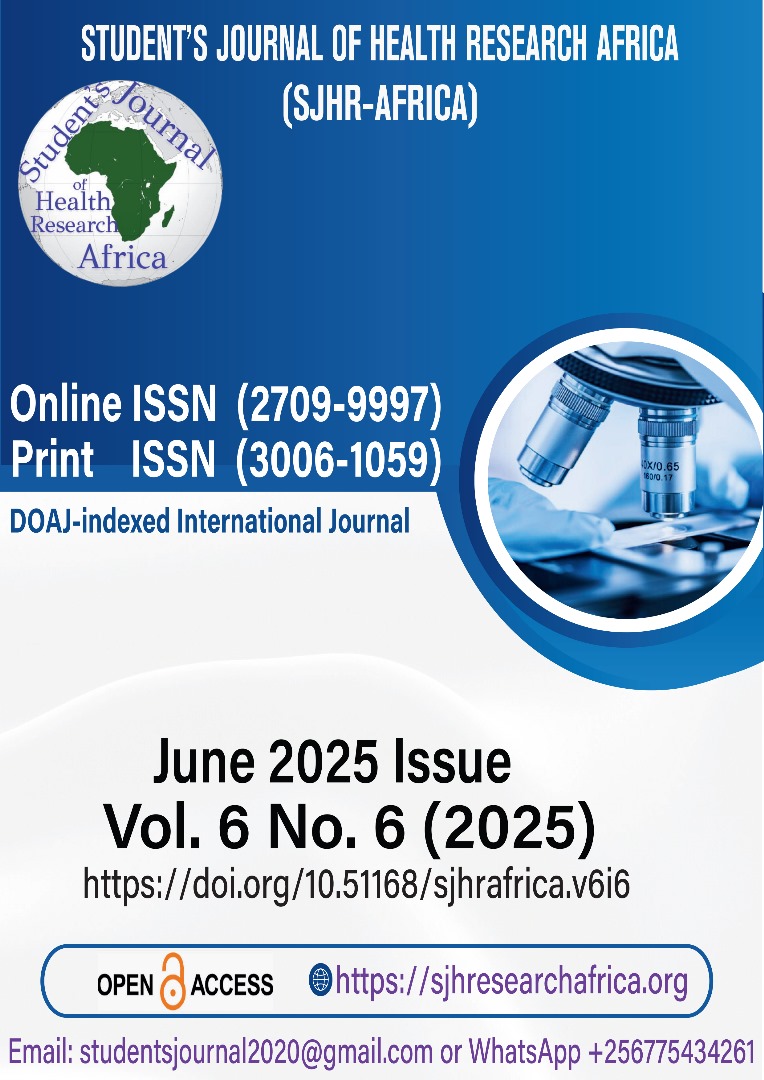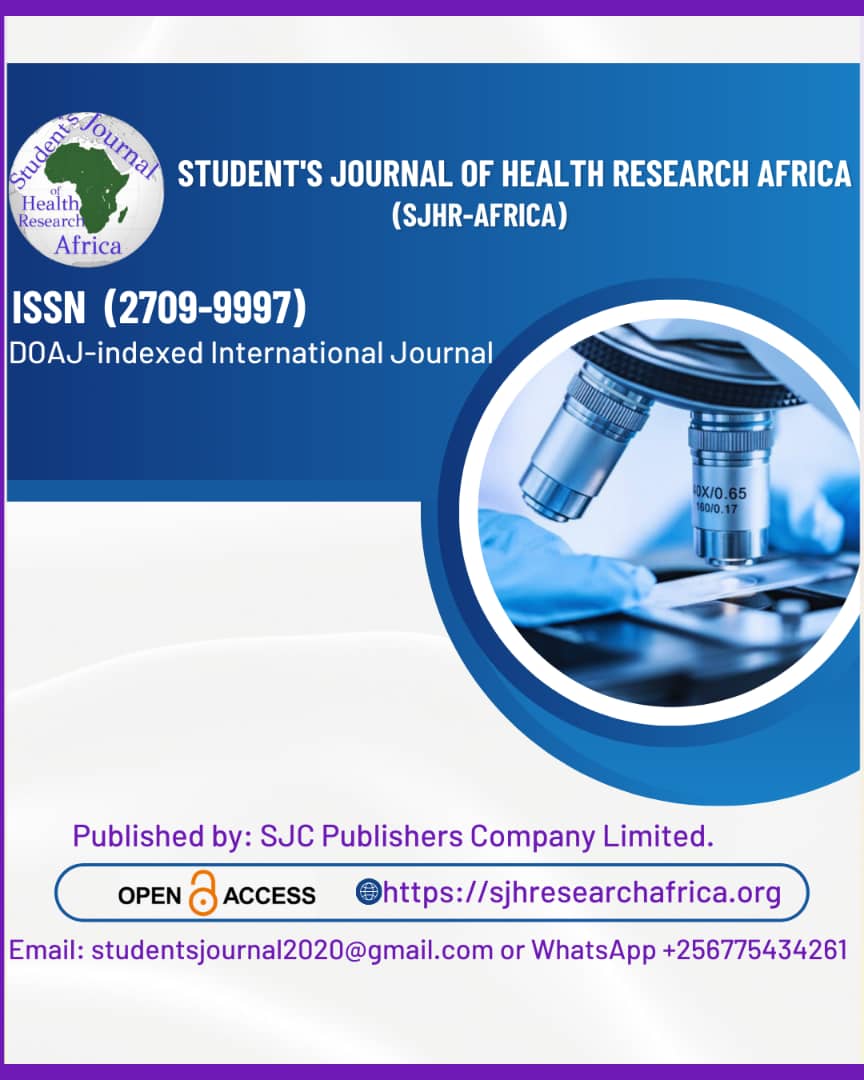PREVALENCE, ANTIBIOTIC RESISTANCE, AND RISK FACTORS OF BACTERIAL PATHOGENS IN “ROLEX FOOD” AT MAKERERE UNIVERSITY: A CROSS-SECTIONAL STUDY.
DOI:
https://doi.org/10.51168/sjhrafrica.v6i6.1429Keywords:
Drug susceptibility, isolates, antibiotic resistance, bacterial pathogens, food poisoning, street food, UgandaAbstract
Background
This was a baseline study aimed at determining bacterial load in Rolex food sold in selected points of Kikumi kikumi in MUK, establishing the antibiograms of E. coli, Staphylococcus aureus, and Salmonella spp, screening for mecA and Tet M genes in the isolates that code for resistance to penicillin and tetracycline, respectively.
Methods and tools
A total of 50 samples were collected, of which 25 of them had raw salads while the remaining had their salads cooked in omelettes. Isolation and identification were done, and antibacterial susceptibility was done using a disc diffusion test.
Results
The results showed that 11.50% of 50 samples collected were positive with common bacterial contaminants, and in these positive samples, E. coli and CNS were the most prevalent with 30.43% and 26.09%, respectively followed by Klebsiella spp and Pseudomonas Spp with a same prevalence of 15.22%, Bacillus spp 6.52%, Streptococcus Spp 4.35% and then Staphylococcus aureus with the lowest prevalence of 2.17%, while Salmonella Spp were not found completely in the samples. The susceptibility tests on E. coli showed that CXC had the highest resistance of 93.75%, followed by SXT and GM with resistance of 43.73% and 37.50%, respectively.
Conclusion
This study revealed that Rolex food, particularly when containing raw salads, harbors a significant bacterial load, with E. coli and coagulase-negative staphylococci (CNS) being the most prevalent contaminants. E. coli isolates exhibited high resistance to cefotaxime (93.75%), trimethoprim-sulfamethoxazole (43.73%), and gentamicin (37.50%), raising concerns about potential treatment challenges.
Recommendations
People should buy cooked Rolex food as opposed to raw one because of its low prevalence of bacterial contaminants. The Rolex makers should clean their clothes, acquire and put on aprons all the time while operating, and above all, wash their hands with clean water every time they serve customers.
References
Al Mamun, M., Rahman, S. M. M., & Turin, T. C. (2013). Microbiological quality of selected street food items vended by school-based street food vendors in Dhaka, Bangladesh. International Journal of Food Microbiology, 166(3), 413-418. https://doi.org/10.1016/j.ijfoodmicro.2013.08.007 PMid:24029025
Becker, K., Heilmann, C., & Peters, G. (2014). Coagulase-negative staphylococci. Clinical Microbiology Reviews, 27(4), 870-926. https://doi.org/10.1128/CMR.00109/13 PMid: 25278577 PMCid: PMC4187637
Cohen, M. J., & Garrett, J. L. (2010). The food price crisis and urban food (in)security. Environment and Urbanization, 22(2), 467-482. https://doi.org/10.1177/0956247810380375
H, T. D., V, K. R., Shirsat, S. D., & Bhadange, D. G. (2011). BACTERIOLOGICAL QUALITY OF STREET VENDED FOOD PANIPURI: A CASE STUDY OF AMRAVATI CITY (MS), INDIA. In Bioscience Discovery (Vol. 2). Retrieved from http://www.biosciencediscovery.com
Kanti Mali, S., Rabiul Haque, M., Chandra Sen, L., Debnath, S., Professor, A., Professor, A., & Author, C. (2019). Vendors and Consumers Status, Water Quality and Microbial Analysis of Street Side Foods in Patuakhali District. International Journal of Health Sciences & Research (Www.Ijhsr.Org), 9, 12. Retrieved from www.ijhsr.org
Lopes Nonato, I., Oliveira de Almeida Minussi, L., Benedetti Pascoal, G., & Abadia De-Souza, D. (2016). Nutritional Issues Concerning Street Foods. J Clin Nutr Diet, 2, 1. https://doi.org/10.4172/2472-1921.100014
Mackay, H. (2019). Food sources and access strategies in Ugandan secondary cities: an intersectional analysis. 31(2), 375-396. https://doi.org/10.1177/0956247819847346 https://doi.org/10.1177/0956247819847346
Mbae, K. M., Ndwiga, M. K., & Kiruki, F. G. (2018). Microbiological Quality of Kachumbari, a Raw Vegetable Salad Popularly Served Alongside Roast Meat in Kenya. https://doi.org/10.1155/2018/8539029
Moore, E., Arnscheidt, A., & Mau, M. (2004). Simplified protocols for the preparation of genomic DNA from bacterial cultures. 3-18.
Mugampoza, D., Byarugaba, G. W. B., Nyonyintono, A., & Nakitto, P. (2013a). AMERICAN JOURNAL OF FOOD AND NUTRITION Occurrence of Escherichia coli and Salmonella spp. in street-vended foods and general hygienic and trading practices in Nakawa Division, Uganda. https://doi.org/10.5251/ajfn.2013.3.3.167.175
Mugampoza, D., Byarugaba, G. W. B., Nyonyintono, A., & Nakitto, P. (2013b). AMERICAN JOURNAL OF FOOD AND NUTRITION Occurrence of Escherichia coli and Salmonella spp. in street-vended foods and general hygienic and trading practices in Nakawa Division, Uganda. https://doi.org/10.5251/ajfn.2013.3.3.167.175
Mulindwa, D. (2019). Analysing Street food in Uganda from a Transformative Social Innovation Perspective: Street Food, Urban Poor, Empowerment, Social Innovation. In Critical Tourism Studies Proceedings (Vol. 2019).
Muyanja, C., Nayiga, L., Brenda, N., & Nasinyama, G. (2011). Practices, knowledge, and risk factors of street food vendors in Uganda. Food Control, 22(10), 1551-1558. https://doi.org/10.1016/j.foodcont.2011.01.016
Namugumya, B. S., & Muyanja, C. (n.d.). Contribution of street foods to the dietary needs of street food vendors in Kampala, Jinja, and Masaka districts, Uganda. Public Health Nutrition, (8), 1503-1511. https://doi.org/10.1017/S1368980011002710 PMid:22015148
Rane, S. (2011, January). Street Vended Food in the Developing World: Hazard Analyses. Indian Journal of Microbiology, Vol. 51, pp. 100-106. https://doi.org/10.1007/s12088-011-0154-x PMid: 22282636 PMCid: PMC3209856
Schuurmans, A. (2016). EXPLORING STREET FOODS AS AN ASSEMBLAGE: A case study of the street food sector in Kampala area, Uganda.
Al Mamun, M., Rahman, S. M. M., & Turin, T. C. (2013). Microbiological quality of selected street food items vended by school-based street food vendors in Dhaka, Bangladesh. International Journal of Food Microbiology, 166(3), 413-418. https://doi.org/10.1016/j.ijfoodmicro.2013.08.007 PMid:24029025
Becker, K., Heilmann, C., & Peters, G. (2014). Coagulase-negative staphylococci. Clinical Microbiology Reviews, 27(4), 870-926. https://doi.org/10.1128/CMR.00109/13 PMid: 25278577 PMCid: PMC4187637
Cohen, M. J., & Garrett, J. L. (2010). The food price crisis and urban food (in)security. Environment and Urbanization, 22(2), 467-482. https://doi.org/10.1177/0956247810380375
H, T. D., V, K. R., Shirsat, S. D., & Bhadange, D. G. (2011). BACTERIOLOGICAL QUALITY OF STREET VENDED FOOD PANIPURI: A CASE STUDY OF AMRAVATI CITY (MS), INDIA. In Bioscience Discovery (Vol. 2). Retrieved from http://www.biosciencediscovery.com
Kanti Mali, S., Rabiul Haque, M., Chandra Sen, L., Debnath, S., Professor, A., Professor, A., & Author, C. (2019). Vendors and Consumers Status, Water Quality and Microbial Analysis of Street Side Foods in Patuakhali District. International Journal of Health Sciences & Research (Www.Ijhsr.Org), 9, 12. Retrieved from www.ijhsr.org
Lopes Nonato, I., Oliveira de Almeida Minussi, L., Benedetti Pascoal, G., & Abadia De-Souza, D. (2016). Nutritional Issues Concerning Street Foods. J Clin Nutr Diet, 2, 1. https://doi.org/10.4172/2472-1921.100014
https://doi.org/10.4172/2472-1921.100014
Mackay, H. (2019). Food sources and access strategies in Ugandan secondary cities: an intersectional analysis. 31(2), 375-396. https://doi.org/10.1177/0956247819847346
Mbae, K. M., Ndwiga, M. K., & Kiruki, F. G. (2018). Microbiological Quality of Kachumbari, a Raw Vegetable Salad Popularly Served Alongside Roast Meat in Kenya. https://doi.org/10.1155/2018/8539029
Moore, E., Arnscheidt, A., & Mau, M. (2004). Simplified protocols for the preparation of genomic DNA from bacterial cultures. 3-18.
Mugampoza, D., Byarugaba, G. W. B., Nyonyintono, A., & Nakitto, P. (2013a). AMERICAN JOURNAL OF FOOD AND NUTRITION Occurrence of Escherichia coli and Salmonella spp. in street-vended foods and general hygienic and trading practices in Nakawa Division, Uganda. https://doi.org/10.5251/ajfn.2013.3.3.167.175
Mugampoza, D., Byarugaba, G. W. B., Nyonyintono, A., & Nakitto, P. (2013b). AMERICAN JOURNAL OF FOOD AND NUTRITION Occurrence of Escherichia coli and Salmonella spp. in street-vended foods and general hygienic and trading practices in Nakawa Division, Uganda. https://doi.org/10.5251/ajfn.2013.3.3.167.175
Mulindwa, D. (2019). Analysing Street food in Uganda from a Transformative Social Innovation Perspective: Street Food, Urban Poor, Empowerment, Social Innovation. In Critical Tourism Studies Proceedings (Vol. 2019).
Muyanja, C., Nayiga, L., Brenda, N., & Nasinyama, G. (2011). Practices, knowledge, and risk factors of street food vendors in Uganda. Food Control, 22(10), 1551-1558. https://doi.org/10.1016/j.foodcont.2011.01.016
Namugumya, B. S., & Muyanja, C. (n.d.). Contribution of street foods to the dietary needs of street food vendors in Kampala, Jinja, and Masaka districts, Uganda. Public Health Nutrition, (8), 1503-1511. https://doi.org/10.1017/S1368980011002710 PMid:22015148
Rane, S. (2011, January). Street Vended Food in the Developing World: Hazard Analyses. Indian Journal of Microbiology, Vol. 51, pp. 100-106. https://doi.org/10.1007/s12088-011-0154-xPMid:22282636 PMCid: PMC3209856
Schuurmans, A. (2016). Exploring street foods as an assemblage: A case study of the street food sector in Kampala area, Uganda.
Downloads
Published
How to Cite
Issue
Section
License
Copyright (c) 2025 Isaac Isiko, Okoro Lenz Nwachinemere, Elijah Otokpa, Ovye AHGU, Jackson Micheal Asingwire, Evaristo Philemon Willa, Zulfah Nabisere, Sharifah Bukenya Namatovu

This work is licensed under a Creative Commons Attribution-NonCommercial-NoDerivatives 4.0 International License.






















